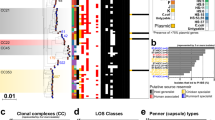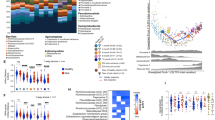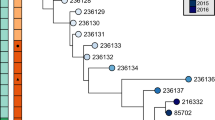Abstract
Campylobacter jejuni infections are a leading cause of bacterial food-borne diarrhoeal illness worldwide, and Campylobacter infections in children are associated with stunted growth and therefore long-term deficits into adulthood. Despite this global impact on health and human capital, how zoonotic C. jejuni responds to the human host remains unclear. Unlike other intestinal pathogens, C. jejuni does not harbour pathogen-defining toxins that explicitly contribute to disease in humans. This makes understanding Campylobacter pathogenesis challenging and supports a broad examination of bacterial factors that contribute to C. jejuni infection. Here, we use a controlled human infection model to characterize C. jejuni transcriptional and genetic adaptations in vivo, along with a non-human primate infection model to validate our approach. We found that variation in 11 genes is associated with either acute or persistent human infections and includes products involved in host cell invasion, bile sensing and flagella modification, plus additional potential therapeutic targets. In particular, a functional version of the cell invasion protein A (cipA) gene product is strongly associated with persistently infecting bacteria and we identified its biochemical role in flagella modification. These data characterize the adaptive C. jejuni response to primate infections and suggest therapy design should consider the intrinsic differences between acute and persistently infecting bacteria. In addition, RNA sequencing revealed conserved responses during natural host commensalism and human infections. Thirty-nine genes were differentially regulated in vivo across hosts, lifestyles and C. jejuni strains. This conserved in vivo response highlights important C. jejuni survival mechanisms such as iron acquisition and evasion of the host mucosal immune response. These advances highlight pathogen adaptability across host species and demonstrate the utility of multidisciplinary collaborations in future clinical trials to study pathogens in vivo.
This is a preview of subscription content, access via your institution
Access options
Access Nature and 54 other Nature Portfolio journals
Get Nature+, our best-value online-access subscription
$29.99 / 30 days
cancel any time
Subscribe to this journal
Receive 12 digital issues and online access to articles
$119.00 per year
only $9.92 per issue
Buy this article
- Purchase on Springer Link
- Instant access to full article PDF
Prices may be subject to local taxes which are calculated during checkout




Similar content being viewed by others

References
Lieberman, T. D. et al. Parallel bacterial evolution within multiple patients identifies candidate pathogenicity genes. Nat. Genet. 43, 1275–1280 (2011).
Yang, L. et al. Evolutionary dynamics of bacteria in a human host environment. Proc. Natl Acad. Sci. USA 108, 7481–7486 (2011).
Harris, S. R. et al. Evolution of MRSA during hospital transmission and intercontinental spread. Science 327, 469–474 (2010).
Kennemann, L. et al. Helicobacter pylori genome evolution during human infection. Proc. Natl Acad. Sci. USA 108, 5033–5038 (2011).
Zdziarski, J. et al. Host imprints on bacterial genomes—rapid, divergent evolution in individual patients. PLoS Pathog. 6, e1001078 (2010).
Copin, R. et al. Within host evolution selects for a dominant genotype of Mycobacterium tuberculosis while T cells increase pathogen genetic diversity. PLoS Pathog. 12, e1006111 (2016).
Bayliss, C. D. et al. Phase variable genes of Campylobacter jejuni exhibit high mutation rates and specific mutational patterns but mutability is not the major determinant of population structure during host colonization. Nucleic Acids Res. 40, 5876–5889 (2012).
Bergman, M., Del Prete, G., van Kooyk, Y. & Appelmelk, B. Helicobacter pylori phase variation, immune modulation and gastric autoimmunity. Nat. Rev. Microbiol. 4, 151–159 (2006).
Srikhanta, Y. N., Fox, K. L. & Jennings, M. P. The phasevarion: phase variation of type III DNA methyltransferases controls coordinated switching in multiple genes. Nat. Rev. Microbiol. 8, 196–206 (2010).
Kim, J. -S. et al. Passage of Campylobacter jejuni through the chicken reservoir or mice promotes phase variation in contingency genes Cj0045 and Cj0170 that strongly associates with colonization and disease in a mouse model. Microbiology 158, 1304–1316 (2012).
Jerome, J. P. et al. Standing genetic variation in contingency loci drives the rapid adaptation of Campylobacter jejuni to a novel host. PLoS ONE 6, e16399 (2011).
Mohawk, K. L., Poly, F., Sahl, J. W., Rasko, D. A. & Guerry, P. High frequency, spontaneous motA mutations in Campylobacter jejuni strain 81–176. PLoS ONE 9, e88043 (2014).
Amour, C. et al. Epidemiology and impact of Campylobacter infection in children in 8 low-resource settings: results from the MAL-ED study. Clin. Infect. Clin. Infect. Dis. 63, 1171–1179 (2016).
Cawthraw, S. A., Wassenaar, T. M., Ayling, R. & Newell, D. G. Increased colonization potential of Campylobacter jejuni strain 81116 after passage through chickens and its implication on the rate of transmission within flocks. Epidemiol. Infect. 117, 213–215 (1996).
Rimmer, J. E. et al. Rifaximin fails to prevent campylobacteriosis in the human challenge model: a randomized, double-blind, placebo-controlled trial. Clin. Infect. Dis. https://doi.org/10.1093/cid/cix1014 (2017).
Baqar, S. et al. Recrudescent Campylobacter jejuni infection in an immunocompetent adult following experimental infection with a well-characterized organism. Clin. Vaccin. Immunol. CVI 17, 80–86 (2010).
Palyada, K., Threadgill, D. & Stintzi, A. Iron acquisition and regulation in Campylobacter jejuni. J. Bacteriol. 186, 4714–4729 (2004).
Brás, A. M., Chatterjee, S., Wren, B. W., Newell, D. G. & Ketley, J. M. A novel Campylobacter jejuni two-component regulatory system important for temperature-dependent growth and colonization. J. Bacteriol. 181, 3298–3302 (1999).
Del Rocio Leon-Kempis, M., Guccione, E., Mulholland, F., Williamson, M. P. & Kelly, D. J. The Campylobacter jejuni PEB1a adhesin is an aspartate/glutamate-binding protein of an ABC transporter essential for microaerobic growth on dicarboxylic amino acids. Mol. Microbiol. 60, 1262–1275 (2006).
Ziprin, R. L. et al. Role of Campylobacter jejuni potential virulence genes in cecal colonization. Avian. Dis. 45, 549–557 (2001).
Jones, M. A. et al. Adaptation of Campylobacter jejuni NCTC11168 to high-level colonization of the avian gastrointestinal tract. Infect. Immun. 72, 3769–3776 (2004).
Fields, J. A. & Thompson, S. A. Campylobacter jejuni CsrA mediates oxidative stress responses, biofilm formation, and host cell invasion. J. Bacteriol. 190, 3411–3416 (2008).
Taveirne, M. E., Theriot, C. M., Livny, J. & DiRita, V. J. The complete Campylobacter jejuni transcriptome during colonization of a natural host determined by RNAseq. PLoS ONE 8, e73586 (2013).
Corcionivoschi, N. et al. Mucosal reactive oxygen species decrease virulence by disrupting Campylobacter jejuni phosphotyrosine signaling. Cell Host Microbe 12, 47–59 (2012).
Pryjma, M., Apel, D., Huynh, S., Parker, C. T. & Gaynor, E. C. FdhTU-modulated formate dehydrogenase expression and electron donor availability enhance recovery of Campylobacter jejuni following host cell infection. J. Bacteriol. 194, 3803–3813 (2012).
Johnson, J. G., Gaddy, J. A. & DiRita, V. J. The PAS domain-containing protein HeuR regulates heme uptake in Campylobacter jejuni. mBio 7, e01691–16 (2016).
Naikare, H. et al. Campylobacter jejuni ferric-enterobactin receptor CfrA is TonB3 dependent and mediates iron acquisition from structurally different catechol siderophores. Met. Integr. Biometal Sci. 5, 988–996 (2013).
Hoang, K. V., Wang, Y. & Lin, J. Identification of genetic loci that contribute to Campylobacter resistance to fowlicidin-1, a chicken host defense peptide. Front. Cell. Infect. Microbiol. 2, 32 (2012).
Cameron, A. et al. High-frequency variation of purine biosynthesis genes is a mechanism of success in Campylobacter jejuni. mBio 6, e00612–15 (2015).
Barrero-Tobon, A. M. & Hendrixson, D. R. Identification and analysis of flagellar coexpressed determinants (Feds) of Campylobacter jejuni involved in colonization. Mol. Microbiol. 84, 352–369 (2012).
Luethy, P. M., Huynh, S., Parker, C. T. & Hendrixson, D. R. Analysis of the activity and regulon of the two-component regulatory system composed by Cjj81176_1484 and Cjj81176_1483 of Campylobacter jejuni. J. Bacteriol. 197, 1592–1605 (2015).
Javed, M. A. et al. Transposon mutagenesis in a hyper-invasive clinical isolate of Campylobacter jejuni reveals a number of genes with potential roles in invasion. Microbiology 156, 1134–1143 (2010).
Poli, V. F. S., Thorsen, L., Olesen, I., Wik, M. T. & Jespersen, L. Differentiation of the virulence potential of Campylobacter jejuni strains by use of gene transcription analysis and a Caco-2 assay. Int. J. Food Microbiol. 155, 60–68 (2012).
Guo, B. et al. CmeR functions as a pleiotropic regulator and is required for optimal colonization of Campylobacter jejuni in vivo. J. Bacteriol. 190, 1879–1890 (2008).
Lei, H. -T. et al. Crystal structures of CmeR-bile acid complexes from Campylobacter jejuni. Protein Sci. Publ. Protein Soc. 20, 712–723 (2011).
Lin, J., Overbye Michel, L. & Zhang, Q. CmeABC functions as a multidrug efflux system in Campylobacter jejuni. Antimicrob. Agents Chemother. 46, 2124–2131 (2002).
Grinnage-Pulley, T. & Zhang, Q. Genetic basis and functional consequences of differential expression of the CmeABC efflux pump in Campylobacter jejuni isolates. PLoS ONE 10, e0131534 (2015).
Lin, J., Sahin, O., Michel, L. O. & Zhang, Q. Critical role of multidrug efflux pump CmeABC in bile resistance and in vivo colonization of Campylobacter jejuni. Infect. Immun. 71, 4250–4259 (2003).
Guerry, P. et al. Changes in flagellin glycosylation affect Campylobacter autoagglutination and virulence. Mol. Microbiol. 60, 299–311 (2006).
Howard, S. L. et al. Campylobacter jejuni glycosylation island important in cell charge, legionaminic acid biosynthesis, and colonization of chickens. Infect. Immun. 77, 2544–2556 (2009).
Murray, J. L., Kwon, T., Marcotte, E. M. & Whiteley, M. Intrinsic antimicrobial resistance determinants in the super bug Pseudomonas aeruginosa. mBio 6, e01603–15 2015).
Turner, K. H., Wessel, A. K., Palmer, G. C., Murray, J. L. & Whiteley, M. Essential genome of Pseudomonas aeruginosa in cystic fibrosis sputum. Proc. Natl Acad. Sci. USA 112, 4110–4115 (2015).
Kaas, R. S., Leekitcharoenphon, P., Aarestrup, F. M. & Lund, O. Solving the problem of comparing whole bacterial genomes across different sequencing platforms. PLoS ONE 9, e104984 (2014).
Monteiro, M. A. et al. Capsule polysaccharide conjugate vaccine against diarrheal disease caused by Campylobacter jejuni. Infect. Immun. 77, 1128–1136 (2009).
Jones, F. R. et al. New World monkey Aotus nancymae as a model for Campylobacter jejuni infection and immunity. Infect. Immun. 74, 790–793 (2006).
Pequegnat, B. et al. Phase variable changes in the position of O-methyl phosphoramidate modifications on the polysaccharide capsule of Campylobacter jejuni modulate serum resistance. J. Bacteriol. 199, e00027–17 (2017).
Thibault, P. et al. Identification of the carbohydrate moieties and glycosylation motifs in Campylobacter jejuni flagellin. J. Biol. Chem. 276, 34862–34870 (2001).
Acknowledgements
We thank E.J. Rubin for support in developing nucleic acid extraction protocols; H. Ochman and M.A. Leibold for feedback on this project; S.M. Giovanetti for insightful discussion on figures. This work was supported by the National Institutes of Health (NIH) (AI064184 to M.S.T.), the Military Infectious Diseases Research Program (6000.RAD1.DA3.A0308), and the Navy Advanced Medical Development Program (NMRC enterprise Work Unit NumberA1406). This work was funded by the Military Infectious Diseases Research Program, Navy Work Unit 6000.RAD1.DA3.A0308 the Naval Medical Research Center’s Advanced Medical Development Program (NMRC enterprise Work Unit Number A1406). The views expressed in this article are those of the authors and do not necessarily reflect the official policy or position of the Department of the Navy, Department of Defense, nor the U.S. government. P.G., D.R.T., F.M.P., C.K.P., R.L.G., M.S.R. and A.J.M. are either employees of the U.S. government or military service members and this work was prepared as part of their official duties. Title 17 USC 105 provides that ‘Copyright protection under this title is not available for any work of the United States government.’ Title 17 USC 101 defines a U.S. government work as a work prepared by a military service member or employee of the U.S. government as part of that person’s official duties.
Author information
Authors and Affiliations
Contributions
A.A.C. conceived, designed, preformed and interpreted genetic and transcriptomic analyses and wrote the paper. P.G. and M.S.T. established this collaborative project and oversaw this study. B.W.D. and M.S.T. oversaw computational analyses. A.A.C., M.S.T. and P.G. provided critical biological interpretations of the data. J.E.R, C.H., D.S., K.R.T., C.K.P., R.L.G., B.D., J.B., R.M.L., A.C.M., K.J., A.A., D.R.T. and M.S.R. conducted the clinical trial. F.M.P. and J.M.K. collected specimens for transcriptomics. C.P.E. performed experiments relevant to biological interpretation of the data. A.R. and A.J.M. performed the non-human primate experiments. B.W.D., P.G. and M.S.T supervised this work and edited the manuscript.
Corresponding authors
Ethics declarations
Competing interests
The authors declare no competing interests.
Additional information
Publisher’s note: Springer Nature remains neutral with regard to jurisdictional claims in published maps and institutional affiliations.
Supplementary information
Supplementary Information
Supplementary Figures 1–6 and Supplementary References
Supplementary Tables
Supplementary Tables 1–13
Rights and permissions
About this article
Cite this article
Crofts, A.A., Poly, F.M., Ewing, C.P. et al. Campylobacter jejuni transcriptional and genetic adaptation during human infection. Nat Microbiol 3, 494–502 (2018). https://doi.org/10.1038/s41564-018-0133-7
Received:
Accepted:
Published:
Issue Date:
DOI: https://doi.org/10.1038/s41564-018-0133-7
This article is cited by
-
Trace metal elements: a bridge between host and intestinal microorganisms
Science China Life Sciences (2023)
-
Genomic adaptations of Campylobacter jejuni to long-term human colonization
Gut Pathogens (2021)
-
Campylobacter sp.: Pathogenicity factors and prevention methods—new molecular targets for innovative antivirulence drugs?
Applied Microbiology and Biotechnology (2020)
-
Climate, human behaviour or environment: individual-based modelling of Campylobacter seasonality and strategies to reduce disease burden
Journal of Translational Medicine (2019)
-
Microevolution of Neisseria lactamica during nasopharyngeal colonisation induced by controlled human infection
Nature Communications (2018)


